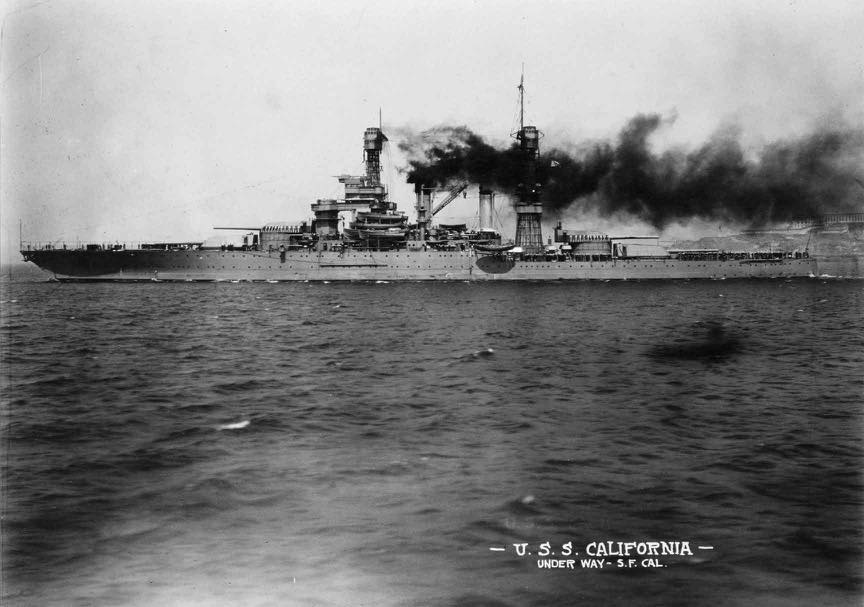USS California BB-44

The fifth California (BB-44) was launched on 20 November 1919 by Mare Island Navy Yard, sponsored by Mrs. R.T. Zane, and commissioned on 10 August 1921 with Captain H.J. Ziegemeier in command. It reported to the Pacific Fleet as the flagship.
From 1921 to 1941, California served as the flagship of the Pacific Fleet and later as the flagship of the Battle Fleet (Battle Force), U.S. Fleet. Its annual activities included joint Army-Navy exercises, tactical and organizational development problems, and fleet concentrations for various purposes. The ship won the Battle Efficiency Pennant for 1921-22 and the Gunnery "E" for 1925-26 due to its intensive training and superior performance.
In the summer of 1925, California led the Battle Fleet and a division of cruisers from the Scouting Fleet on a successful goodwill cruise to Australia and New Zealand. It participated in the Presidential reviews of 1927, 1930, and 1934. The ship underwent modernization in late 1929 and early 1930, receiving an improved anti-aircraft battery.
In 1940, California's base was shifted to Pearl Harbor. On 7 December 1941, during the Japanese aerial attack on Pearl Harbor, California, moored at the southernmost berth of "Battleship Row," suffered significant damage. At 0805, a bomb exploded below decks, igniting an anti-aircraft ammunition magazine and killing about 60 men. A second bomb ruptured her bow plates. Despite efforts to keep her afloat, California settled into the mud with only her superstructure remaining above the surface, resulting in 98 crew members lost and 61 wounded.
California was refloated on 26 March 1942 and dry-docked at Pearl Harbor for repairs. On 7 June, she departed under her own power for Puget Sound Navy Yard, where major reconstruction was undertaken, including improvements to protection, stability, anti-aircraft battery, and fire control system.
Departing Bremerton on 31 January 1944 for shakedown at San Pedro, California sailed from San Francisco on 5 May for the invasion of the Marianas. Off Saipan in June, she conducted effective shore bombardment and call fire missions. On 14 June, she was hit by a shell from an enemy shore battery, resulting in one fatality and nine injuries. Following the Saipan operation, her heavy guns supported assaults on Guam and Tinian (18 July - 9 August). On 24 August, she arrived at Espiritu Santo for repairs to her port bow, damaged in a collision with Tennessee (BB-43).
On 17 September 1944, California sailed to Manus to prepare for the invasion of the Philippines. From 17 October to 20 November, she played a key role in the Leyte operation, including participating in the Battle of Surigao Strait (25 October). On 1 January 1945, she departed the Palaus for the Luzon landings. While providing shore bombardment at Lingayen Gulf on 6 January, she was hit by a kamikaze plane, resulting in 44 crew members killed and 155 wounded. Despite this, she made temporary repairs on-site and continued her shore bombardment mission. She departed on 23 January for Puget Sound Navy Yard, arriving on 15 February for permanent repairs.
California returned to action at Okinawa on 15 June 1945 and remained in the area until 21 July. Two days later, she joined TF 95 to cover East China Sea minesweeping operations. After a short trip to San Pedro Bay, P.I., in August, the ship departed Okinawa on 20 September to cover the landing of the 6th Army occupation force at Wakanoura Wan, Honshu. Supporting the occupation until 15 October, she then sailed via Singapore, Colombo, and Cape Town to Philadelphia, arriving on 7 December. She was placed in commission in reserve there on 7 August 1946, decommissioned on 14 February 1947, and sold on 10 July 1959.
 >
>